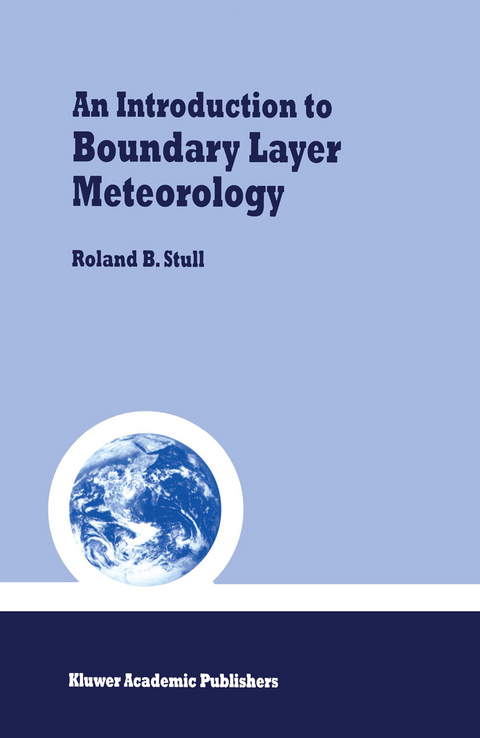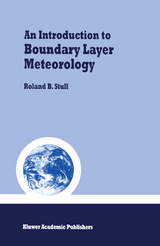An Introduction to Boundary Layer Meteorology
Kluwer Academic Publishers (Verlag)
978-90-277-2769-5 (ISBN)
The work should also be considered as a major reference and as a review of the literature, since it includes tables of parameterizatlons, procedures, filed experiments, useful constants, and graphs of various phenomena under a variety of conditions. It is assumed that the work will be used at the beginning graduate level for students with an undergraduate background in meteorology, but the author envisions, and has catered for, a heterogeneity in the background and experience of his readers.
1 Mean Boundary Layer Characteristics.- 1.1 A boundary-layer definition.- 1.2 Wind and flow.- 1.3 Turbulent transport.- 1.4 Taylor’s hypothesis.- 1.5 Virtual potential temperature.- 1.6 Boundaiy layer depth and structure.- 1.7 Micrometeorology.- 1.8 Significance of the boundary layer.- 1.9 General references.- 1.10 References for this chapter.- 1.11 Exercises.- 2 Some Mathematical and Conceptual Tools: Part 1. Statistics.- 2.1 The significance of turbulence and its spectrum.- 2.2 The spectral gap.- 2.3 Mean and turbulent parts.- 2.4 Some basic statistical methods.- 2.5 Turbulence kinetic energy.- 2.6 Kinematic flux.- 2.7 Eddy flux.- 2.8 Summation notation.- 2.9 Stress.- 2.10 Friction velocity.- 2.11 References.- 2.12 Exercises.- 3 Application of the Governing Equations to Turbulent Flow.- 3.1 Methodology.- 3.2 Basic governing equations.- 3.3 Simplifications, approximations, and scaling arguments.- 3.4 Equations for mean variables in a turbulent flow.- 3.5 Summary of equations, with simplifications.- 3.6 Case studies.- 3.7 References.- 3.8 Exercises.- 4 Prognostic Equations for Turbulent Fluxes and Variances.- 4.1 Prognostic equations for the turbulent departures.- 4.2 Free convection scaling variables.- 4.3 Prognostic equations for variances.- 4.4 Prognostic equations for turbulent fluxes.- 4.5 References.- 4.6 Exercises.- 5 Turbulence Kinetic Energy, Stability, and Scaling.- 5.1 The TKE budget derivation.- 5.2 Contributions to the TKE budget.- 5.3 TKE budget contributions as a function of eddy size.- 5.4 Mean kinetic energy and its interaction with turbulence.- 5.5 Stability concepts.- 5.6 The Richardson number.- 5.7 The Obukhov length.- 5.8 Dimensionless gradients.- 5.9 Miscellaneous scaling parameters.- 5.10 Combined stability tables.- 5.11 References.- 5.12Exercises.- 6 Turbulence Closure Techniques.- 6.1 The closure problem.- 6.2 Parameterization rules.- 6.3 Local closure — zero and half order.- 6.4 Local closure — first order.- 6.5 Local closure — one-and-a-half order.- 6.6 Local closure — second order.- 6.7 Local closure — third order.- 6.8 Nonlocal closure — transilient turbulence theory.- 6.9 Nonlocal closure — spectral diffusivity theory.- 6.10 References.- 6.11 Exercises.- 7 Boundary Conditions and External Forcings.- 7.1 Effective surface turbulent flux.- 7.2 Heat budget at the surface.- 7.3 Radiation budget.- 7.4 Fluxes at interfaces.- 7.5 Partitioning of flux into sensible and latent portions.- 7.6 Flux to and from the ground.- 7.7 References.- 7.8 Exercises.- 8 Some Mathematical and Conceptual Tools: Part 2. Time Series.- 8.1 Time and space series.- 8.2 Autocorrelation.- 8.3 Structure function.- 8.4 Discrete Fourier transform.- 8.5 Fast Fourier Transform.- 8.6 Energy spectrum.- 8.7 Spectral characteristics.- 8.8 Spectra of two variables.- 8.9 Periodogram.- 8.10 Nonlocal spectra.- 8.11 Spectral decomposition of the TKE equation.- 8.12 References.- 8.13 Exercises.- 9 Similarity Theory.- 9.1 An overview.- 9.2 Buckingham Pi dimensional analysis methods.- 9.3 Scaling variables.- 9.4 Stable boundary layer similarity relationship lists.- 9.5 Neutral boundary layer similarity relationship lists.- 9.6 Convective boundary layer similarity relationship lists.- 9.7 The log wind profile.- 9.8 Rossby-number similarity and profile matching.- 9.9 Spectral similarity.- 9.10 Similarity scaling domains.- 9.11 References.- 9.12 Exercises.- 10 Measurement and Simulation Techniques.- 10.1 Sensor and measurement categories.- 10.2 Sensor lists.- 10.3 Active remote sensor observations of morphology.- 10.4 Instrumentplatforms.- 10.5 Field experiments.- 10.6 Simulation methods.- 10.7 Analysis methods.- 10.8 References.- 10.9 Exercises.- 11 Convective Mixed Layer.- 11.1 The unstable surface layer.- 11.2 The mixed layer.- 11.3 Entrainment zone.- 11.4 Entrainment velocity and its parameterization.- 11.5 Subsidence and advection.- 11.6 References.- 11.7 Exercises.- 12 Stable Boundary Layer.- 12.1 Mean Characteristics.- 12.2 Processes.- 12.3 Evolution.- 12.4 Other Depth Models.- 12.5 Low-level (nocturnal) jet.- 12.6 Buoyancy (gravity) waves.- 12.7 Terrain slope and drainage winds.- 12.8 References.- 12.9 Exercises.- 13 Boundary Layer Clouds.- 13.1 Thermodynamics.- 13.2 Radiation.- 13.3 Cloud entrainment mechanisms.- 13.4 Fair-weather cumulus.- 13.5 Stratocumulus.- 13.6 Fog.- 13.7 References.- 13.8 Exercises.- 14 Geographic Effects.- 14.1 Geographically generated local winds.- 14.2 Geographically modified flow.- 14.3 Urban heat island.- 14.4 References.- 14.5 Exercises.- Appendices.- A. Scaling variables and dimensionless groups.- B. Notation.- C. Useful constants parameters and conversion factors.- D. Derivation of virtual potential temperature.- Errata section.
| Erscheint lt. Verlag | 31.7.1988 |
|---|---|
| Reihe/Serie | Atmospheric and Oceanographic Sciences Library ; 13 |
| Zusatzinfo | XIV, 670 p. |
| Verlagsort | Dordrecht |
| Sprache | englisch |
| Maße | 160 x 240 mm |
| Themenwelt | Naturwissenschaften ► Biologie ► Ökologie / Naturschutz |
| Naturwissenschaften ► Geowissenschaften ► Geologie | |
| Naturwissenschaften ► Geowissenschaften ► Meteorologie / Klimatologie | |
| Naturwissenschaften ► Physik / Astronomie ► Mechanik | |
| ISBN-10 | 90-277-2769-4 / 9027727694 |
| ISBN-13 | 978-90-277-2769-5 / 9789027727695 |
| Zustand | Neuware |
| Informationen gemäß Produktsicherheitsverordnung (GPSR) | |
| Haben Sie eine Frage zum Produkt? |
aus dem Bereich




